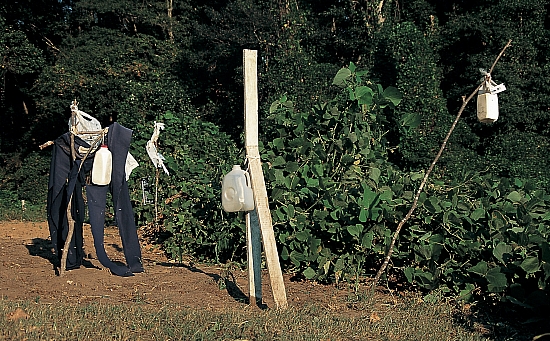"Scarecrows"
Beyond her house and yard, through thick bushes and trees and down a hill, is Sewell's garden. It is on the edge of a gully covered with vines near one of the tallest, densest stands of trees in the vicinity. Throughout the garden, in and around it, are a number of simple but beautiful works of art. "They there to scare the deers away from the garden. Deers, they slip in here at night and make a mess eating up things," she says.
Sewell's "scarecrows" play an interesting dual role in the lower garden, around the outside of her house, and in other nongarden locations. Each of Sewell's assemblage scarecrows could illustrate a sourcebook on traditional African American protective charms, commemorative sculptures, healing devices, and African retentions in the Western Hemisphere. Each scarecrow contains some of the requisite components: roots and natural wood formations, bottles, cans, cloth, and sublte references to ancestral nurture and guidance (parts of bread or milk crates). She ascribes to them the ability to frighten vegetable-eating predators but does not say why so many scarecrow-related objects appear in places where no crops were ever intended to be grown (such as beside the road). Her best explanation: "I just put them things out there." What things? "Them guards."
So if deer or squirrels or birds come, Sewell is protected. If people or bad weather or spirits come, Sewell is also protected.
Drupal Theme and Development By: Cheeky Monkey Media
Site Design By: Constructive
